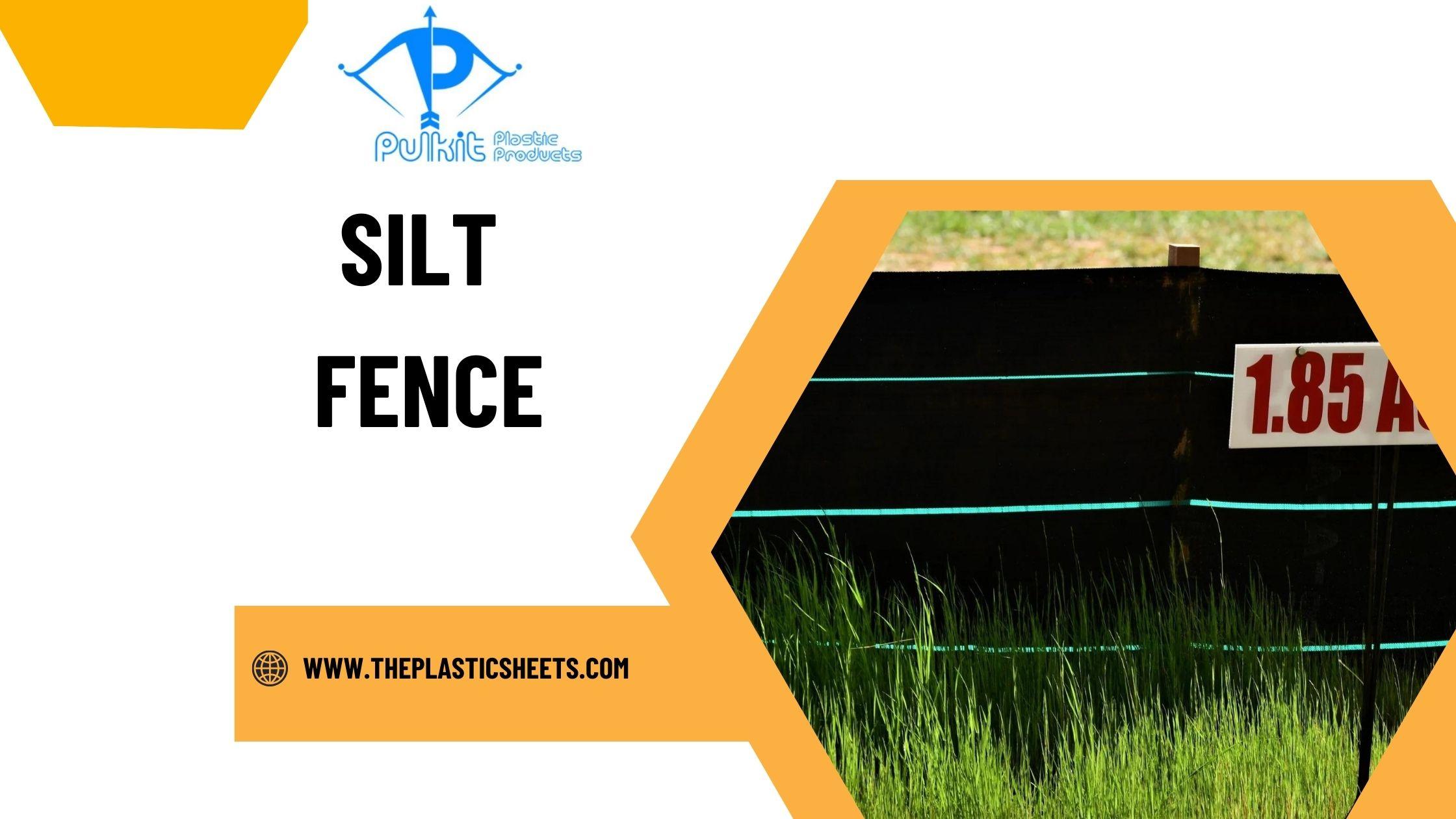When it comes to managing erosion and preventing sediment runoff in construction, landscaping, and civil engineering projects, a silt fence is an essential tool. Simple yet effective, this geotextile barrier plays a significant role in protecting our environment from soil erosion and water contamination. In this article, we’ll explore what a silt fence is, its uses, benefits, installation process, and costs, and answer some common questions. We’ll also discuss where to find reliable silt fence manufacturers in India and highlight Pulkit Plastic Products as a trusted supplier.
What Is a Silt Fence?
A silt fence is a temporary sediment control barrier made from a permeable fabric or mesh material, commonly used to filter out sediment and prevent soil erosion during construction or land disturbance activities. It is designed to trap sediment and allow water to flow through, thereby reducing sedimentation in nearby water bodies.
Typically installed around the perimeter of a construction site, near water bodies or in areas with significant earth-moving activities, silt fences help protect rivers, streams, and lakes from pollution caused by the erosion of disturbed soil. These fences are made of fabric (usually polypropylene or polyester), supported by wooden or metal posts, and are installed in a way that water can pass through but sediment is blocked.
How Does a Silt Fence Work?
The primary function of a silt fence is to reduce sedimentation by filtering out sediment from water runoff. As rainwater flows over disturbed soil, it carries loose particles of sediment, which can degrade water quality and harm aquatic ecosystems. A silt fence acts as a barrier, trapping sediment behind it while allowing the water to pass through the fabric. The mesh material used in a silt fence is specifically designed to filter out fine particles, allowing clean water to flow through and preventing the erosion of the soil.
Benefits of Using a Silt Fence
-
Erosion Control: The most significant benefit of a silt fence is that it helps control soil erosion during construction, land development, or landscaping. It prevents loose soil from washing away and getting into stormwater drains or nearby bodies of water.
-
Improved Water Quality: Silt fences trap sediment, preventing it from contaminating local water sources. This improves water quality in rivers, lakes, and streams, which is essential for maintaining healthy ecosystems.
-
Cost-Effective: Silt fences are relatively inexpensive compared to other erosion control methods. They provide a simple, quick solution to erosion control and are ideal for construction sites, roads, or other projects that involve soil disturbance.
-
Ease of Installation and Removal: Silt fences are easy to install and can be removed after the project is complete. The process is minimally invasive, and they do not require permanent installation, making them ideal for temporary use.
-
Compliance with Regulations: In many regions, construction projects are required to comply with local environmental regulations. Using a silt fence ensures compliance with sediment and erosion control requirements during and after the construction process.
Installation of a Silt Fence
Installing a silt fence involves several key steps to ensure its effectiveness:
-
Site Assessment: First, the area where the silt fence will be installed needs to be assessed. The fence should be placed in areas where runoff water can be controlled and sediment can be effectively trapped.
-
Digging a Trench: A shallow trench is dug along the line where the silt fence will be installed. This ensures that the bottom of the fence is anchored securely to the soil and prevents water from flowing underneath it.
-
Post Installation: Wooden or metal posts are spaced evenly along the trench. These posts will hold the fabric in place and provide the necessary support to the silt fence.
-
Attaching the Fabric: The silt fence fabric is unrolled along the posts and secured using staples, ties, or clips. The fabric is typically buried at the bottom of the trench to prevent sediment from washing underneath it.
-
Maintenance: Regular inspections are necessary to ensure the fence is functioning properly. If the fence becomes clogged with sediment, it may need to be cleaned or replaced. Additionally, the fabric should be inspected for any tears or damage that could reduce its effectiveness.
Silt Fence for Erosion Control
for Silt fences for erosion control are commonly used on construction sites, highways, and other areas where soil is disturbed and runoff is likely to occur. They help prevent the transport of loose soil into storm drains and nearby water bodies, which can cause significant environmental damage. Additionally, silt fences are often used in combination with other erosion control measures, such as sediment basins and check dams, to provide comprehensive protection against soil erosion.
Silt fences are particularly useful in areas where the slope is moderate to steep, and there is a risk of significant sediment transport due to rainfall. Their ability to trap sediment and allow water to flow through makes them ideal for controlling sediment runoff in high-traffic construction zones.
Silt Fence Price
The Silt fence price depends on several factors, including the quality of the material, the length of the fence, and the region in which it’s purchased. On average, the price for a basic silt fence ranges from INR 25 to INR 60 per meter in India, depending on the material and thickness. Additional costs may be incurred for posts, installation, and any maintenance required during the project.
While silt fences are an affordable erosion control option, it’s important to choose high-quality materials that provide the necessary strength and durability. Inexpensive fences made from low-quality materials may not perform as well and can deteriorate quickly under harsh weather conditions.
Silt Fence Manufacturers in India
India’s construction and infrastructure sectors are growing rapidly, creating a strong demand for effective erosion control solutions. Silt fence manufacturers in India have stepped up to meet this demand by providing high-quality, durable products. These manufacturers offer a wide range of options to suit different project sizes and budgets.
Pulkit Plastic Products is one of the leading silt fence manufacturers in India, specializing in high-quality geotextile materials for erosion control. They offer a variety of silt fences made from durable, UV-resistant fabrics, ensuring long-lasting performance. Whether you need silt fences for small residential projects or large-scale commercial developments, Pulkit Plastic Products provides reliable solutions at competitive prices.
Conclusion
A silt fence is a simple yet highly effective tool for controlling erosion and preventing sediment runoff on construction sites, roadways, and other areas prone to soil disturbance. Its ability to trap sediment while allowing water to flow through makes it invaluable in protecting the environment.
If you're looking for affordable, high-quality silt fences, Pulkit Plastic Products offers some of the best options available in India. With their durable, easy-to-install products, you can ensure your construction projects comply with environmental regulations and prevent soil erosion.
Frequently Asked Questions (FAQs)
Q1. What is the primary function of a silt fence?
A: A silt fence prevents sediment from washing off construction sites and disturbing nearby water bodies, providing erosion control and improving water quality.
Q2. How long does a silt fence last?
A: A silt fence can last anywhere from a few months to a couple of years, depending on the material quality and environmental conditions. Regular maintenance can extend its lifespan.
Q3. Can silt fences be used in areas with heavy rainfall?
A: Yes, silt fences are designed to handle moderate to heavy rainfall. However, in areas with frequent and extreme rainfall, additional erosion control measures may be required.



